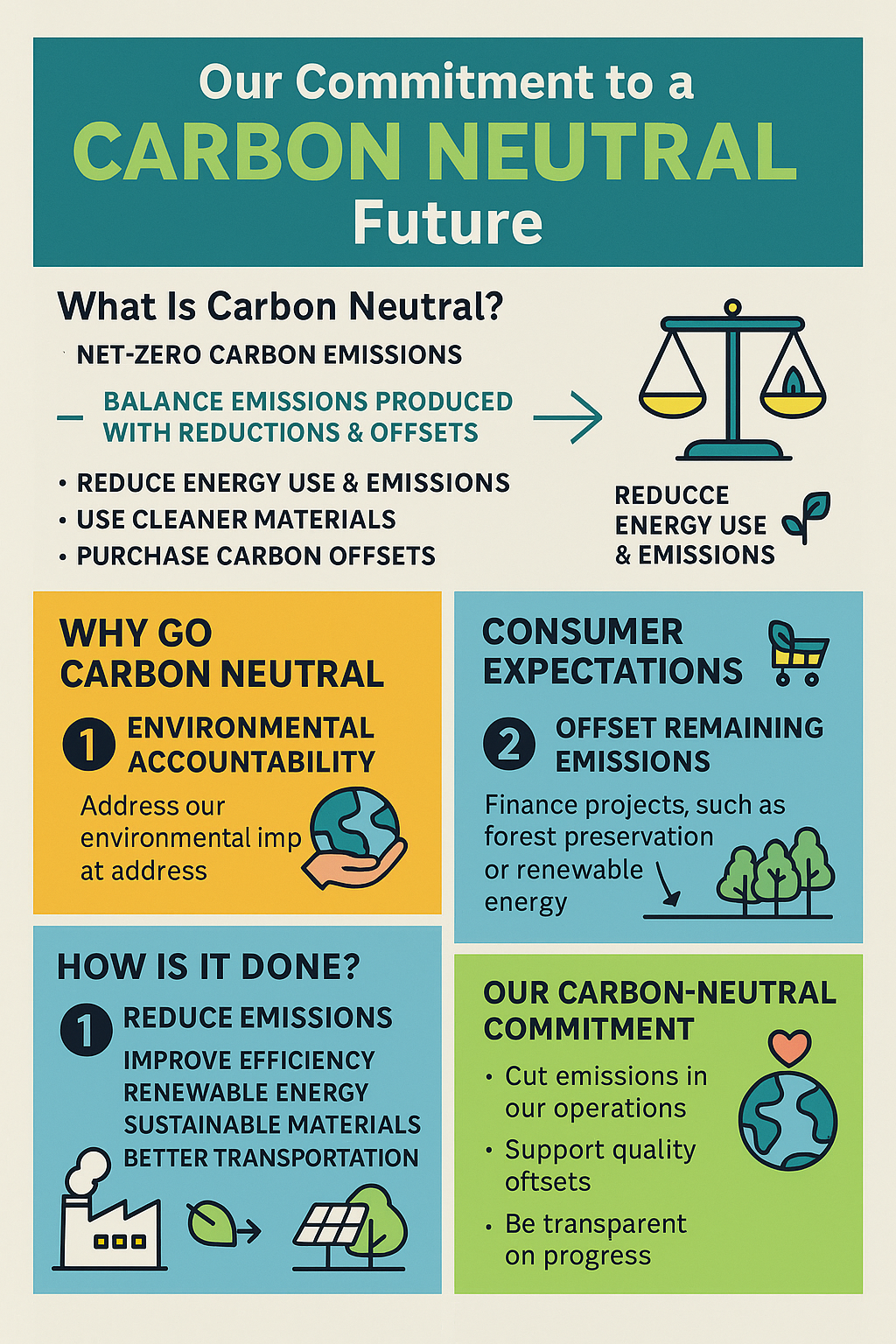
Why We're Going Carbon Neutral — And Why It Matters
Share
Carbon neutrality isn’t just a buzzword — it’s a business responsibility and an environmental imperative. As climate concerns grow, customers, investors, and regulators increasingly expect companies to take measurable action. That’s why we’re committing to a carbon-neutral future, grounded in transparency, science, and impact.
But first — what does "carbon neutral" actually mean?
What Is Carbon Neutrality?
A carbon-neutral product, service, or company balances out the greenhouse gas emissions it produces by reducing what it can and offsetting the rest. This doesn’t mean zero emissions, but it means taking accountability for the emissions created — and working to neutralize their impact on the planet.
This often includes:
-
Reducing energy use and emissions
-
Using cleaner materials or supply chains
-
Purchasing carbon offsets to compensate for remaining emissions
Why Go Carbon Neutral?
There are two major reasons:
1. Environmental Accountability
For organizations that understand the triple bottom line — people, planet, profit — reducing carbon emissions is non-negotiable. Our environmental footprint matters, and carbon neutrality is one way to address it responsibly.
2. Consumer Expectations
Public demand for sustainable brands is growing fast. From travel to tech to retail, people want to buy from companies who align with their values. If we don’t lead on climate, we risk losing the trust of the very people we serve.
“Customers are more interested in dealing with a sustainable retailer who offers clean energy,” says Andrew Koscharsky of Singapore-based electricity retailer iSwitch, which provides carbon-neutral electricity options.
Who’s Leading the Way?
Carbon neutrality has moved far beyond airlines and events. Today, we’re seeing carbon-neutral commitments from:
-
Tech giants like Google and Amazon
-
Financial institutions and pension funds
-
Construction and agriculture companies
-
City governments and entire nations
With transportation and electricity making up nearly half of global emissions, efforts to electrify fleets and decarbonize power generation are especially impactful.
How Is It Done?
There’s no one-size-fits-all method to cut carbon, but here’s the general playbook:
Step 1: Reduce emissions where possible
-
Use energy-efficient systems
-
Shift to renewable power
-
Choose low-impact materials
-
Improve logistics and transportation
Step 2: Offset what you can’t eliminate
Offsets compensate for emissions by funding environmental projects — like:
-
Reforestation or mangrove preservation
-
Renewable energy infrastructure
-
Methane capture from landfills or agriculture
These offsets are tracked via carbon certificates, which are purchased through accredited programs.
Are Carbon Offsets Effective?
It depends.
While many offsets are certified by rigorous standards, the carbon offset market is still evolving. Critics warn about:
-
Inconsistent measurement methods
-
Lack of transparency
-
Offsets being used as a substitute for real reduction
That’s why we prioritize high-quality offsets and — more importantly — focus on cutting emissions at the sourcebefore relying on compensation.
What About Regions Like Singapore?
Singapore faces unique challenges: 95% of its electricity comes from natural gas, and limited land makes large-scale renewable generation difficult.
That’s why companies like iSwitch purchase offsets from international projects, like replacing coal plants in China with wind power.
In 2019, Singapore also introduced a carbon tax to further incentivize emissions reduction — set at S$5/ton and rising to up to S$25/ton by 2030.
Why Not Just Offset Everything?
Offsetting everything might sound simple — but it isn’t a real solution. Experts have compared it to “papal indulgences” or “paying to pollute.” Critics argue that:
-
Offsets can displace responsibility
-
They may not represent real or permanent carbon savings
-
They can enable greenwashing without real change
The goal isn’t just to balance emissions — it’s to reduce them outright.
Our Carbon-Neutral Commitment
We know carbon neutrality isn’t perfect — but it’s a meaningful step toward accountability and better practices. Our approach includes:
-
Auditing and reducing operational emissions
-
Sourcing high-quality, verifiable carbon offsets
-
Being transparent about the projects we support
-
Encouraging our partners and suppliers to do the same
This isn’t about virtue-signaling. It’s about doing the right thing — for our customers, our planet, and future generations.
What Should You Look for in a Carbon-Neutral Brand?
-
Is the company reducing emissions, or just offsetting?
-
What kind of offsets are they purchasing?
-
Are the offsets certified, traceable, and meaningful?
-
Do they report progress publicly and transparently?
Being carbon neutral is only as good as the integrity behind it.
